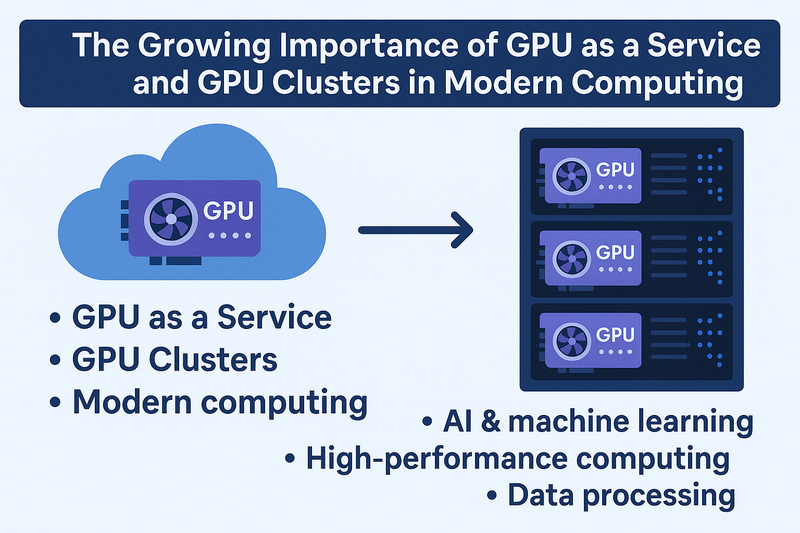In today’s digital world, computing power has become as valuable as capital. From artificial intelligence (AI) models to real-time analytics, businesses are running increasingly complex workloads that demand more than what traditional central processing units (CPUs) can handle efficiently. This is where GPU as a Service and GPU clusters come into play. They are transforming the way enterprises, startups, researchers, and developers scale their innovations without being limited by the constraints of on-premises infrastructure.
The Rise of GPUs in High-Performance Computing
Graphics Processing Units (GPUs) were originally designed to accelerate rendering in video games and graphics applications. However, their unique architecture—capable of parallel processing thousands of threads simultaneously—proved invaluable for computationally heavy tasks beyond graphics.
Today, GPUs are central to:
- AI model training
- Deep learning
- Natural language processing (NLP)
- Scientific simulations
- High-frequency trading
While CPUs are general-purpose and great for sequential tasks, GPUs thrive at performing many operations simultaneously. For instance, training a large-scale AI model on a CPU may take weeks or months, whereas a GPU can reduce that timeframe to days or even hours by parallelizing computations.
What is GPU as a Service?
GPU as a Service (GPUaaS) is a cloud-based offering that gives organizations access to GPU computing infrastructure without requiring them to invest in expensive hardware. Similar to renting storage or CPU cycles in the cloud, companies can utilize GPU processing power on demand.
Key Advantages of GPU as a Service:
- Cost-Efficiency: Avoids high upfront costs of GPUs like NVIDIA L40s or Gpu cloud H100.
- Scalability: Scale GPU usage up or down based on workloads.
- Accessibility: Makes enterprise-level GPU power available to startups.
- Flexibility: Experiment with configurations without hardware constraints.
In short, GPU as a Service democratizes access to cutting-edge computational power, enabling innovation regardless of company size.
The Role of GPU Clusters in Heavy Workloads
Though a single GPU is powerful, certain workloads demand far more processing capacity. This is where GPU clusters are vital.
A GPU cluster links multiple GPUs across a network, enabling them to operate in parallel to tackle highly complex tasks.
Real-World Use Cases of GPU Clusters:
- AI Training: Large language models (LLMs) with billions of parameters.
- Scientific Research: Climate modeling, genomics, astrophysics.
- Financial Services: Real-time risk simulations, algorithmic trading.
- Healthcare: Drug discovery, molecular modeling.
Modern GPU clusters have become increasingly efficient thanks to high-speed networking technologies like NVLink, InfiniBand, and advanced Ethernet, ensuring seamless low-latency communication between GPUs.
GPU as a Service + GPU Clusters: A Powerful Combination
When the flexibility of GPU as a Service intersects with the raw capacity of GPU clusters, businesses gain the ability to access distributed GPU clusters on demand—without building them in-house.
Benefits of this Model:
- Distributed AI training at scale.
- Support for hybrid and multi-cloud strategies.
- Faster time-to-market for AI-driven products.
Example: A startup building an AI video analytics platform can rent GPU clusters for model training and later switch to lighter resources for deployment—saving both cost and time.
Market Growth and Future Outlook
The adoption of GPU as a Service and GPU clusters is growing rapidly. With AI driving digital transformation, industries increasingly rely on high-performance GPU solutions.
Key Trends:
- Multi-tenant GPU clusters: Providers optimize usage by securely sharing clusters across customers.
- Integration with edge computing: Bringing computation closer to data sources for lower latency.
- Sustainability focus: Providers investing in energy-efficient clusters to meet ESG goals.
Research firms like Gartner forecast exponential growth in cloud-based GPU solutions, extending applications to immersive reality, digital twins, and advanced gaming.
Challenges to Consider
Despite their advantages, GPUaaS and clusters come with challenges:
- Cost Management: Risk of bill shocks without workload optimization.
- Data Security: Sensitive workloads demand robust compliance and encryption.
- Vendor Lock-In: Dependence on a single provider limits flexibility—multi-cloud strategies help mitigate this.
Conclusion
The computing landscape is evolving rapidly, with GPU as a Service and GPU clusters at the heart of this shift. Together, they make high-performance computing accessible, scalable, and cost-effective for organizations of all sizes.
From training AI models to running complex simulations, industries are leveraging these GPU-driven solutions to push boundaries and accelerate innovation.
As demand for real-time insights, intelligent applications, and faster product cycles continues to grow, businesses that embrace GPU-driven solutions early will be best positioned to thrive in an increasingly data-driven world.




Top comments (0)